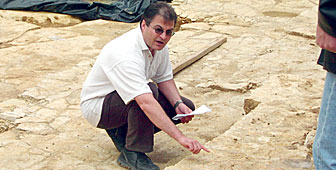Swiss help preserve footprints of time

More than 5,000 huge footprints criss-cross a crumbling wall at a quarry near Sucre, Bolivia – the largest site of dinosaur tracks in the world.
But Cal Orck’o, as it is known locally, is under threat from erosion. To secure the endangered site the Bolivian government has called upon Swiss expertise.
“It surpasses anything I’ve ever seen,” said palaeontologist Christian Meyer, the director of Basel’s Natural History Museum, who led the first team of scientists to map the site in 1998.
Around 68 million years ago herds of dinosaurs used to flock to Cal Orck’o, then a lakeside, in search of food and fresh water.
They left behind an extremely rich geological record: 350 trackways of over 5,000 footprints belonging to 330 different species.
“If you compare Cal Orck’o with the biggest dinosaur sites in Australia, the United States, Asia or Europe, this is by far the largest,” Meyer told swissinfo.
“The diversity of dinosaurs from the late Cretaceous period is frozen in time, just before they became extinct.”
Discovery
The site at Cal Orck’o, discovered by chance by Bolivian workers in 1994, is an imposing 70-degree rockface that stretches for over 1.5 kilometres and climbs in places to 150 metres in height.
Hanging from the huge wall on ropes, Meyer and his team – which included geologists from the Swiss firm Geotest – extensively documented the site in 1998 and 2003. But apart from the number and diversity of dinosaur tracks, they also discovered that the unique monument, in places eight layers deep, was in danger of collapse.
Specialised Swiss know-how has been brought in to secure the wall and the team of geologists and engineers has recently completed the first stage of conservation work.
“Alpine expertise is the best you can get; we are used to securing big walls and overhangs,” said Meyer.
Know-how
Geotest also called on the services of specialist rock engineers, Gasser Felstechnik. The Swiss firm is best known for its recent work securing the rocks above the A2 motorway leading to the Gotthard road tunnel after a fatal rockfall in July.
To combat the damage caused by rainwater seeping through the cracks from above, the cliff-face at Cal Orck’o has been covered with a layer of clay and plastic. Plants have been ripped out and a layer of protective Goretex-like webbing is being tested. Detectors have been installed to measure movement.
The Swiss team is intending to sink up to 900 five-metre long, zinc-plated nails into the rockface to prevent its collapse. But this could be problematic.
“We are still trying to find machinery and heavy equipment to stabilise the wall, but nothing is available in South America,” Meyer said. “But our main goal is to stop quarry workers from continuing to blast away – sometimes they are only 20 metres from the wall,” he explained.
Geotest estimates that the work to secure the wall will cost around SFr3 million ($2.4 million), of which Bolivia has already guaranteed SFr1 million.
Unesco
For Bolivia, preserving the dinosaur site is essential. The authorities have big plans for the future: they hope that, like the nearby town of Sucre, Cal Orck’o can become a Unesco World Heritage site.
Meyer, who has been helping with the Unesco application, is currently in Bolivia on behalf of the Paris-based organisation to help finalise the necessary formal documents. But he acknowledges that the process might take some time.
In the meantime, the local authorities are moving ahead with the development of the site as a tourist attraction. They plan to officially open a mini “Jurassic Park” – a museum complex, together with shops, a restaurant and 15-20 life-size dinosaur models – on August 25.
swissinfo, Simon Bradley
Dinosaurs dominated the earth for over 160 million years, first appearing 230 million years ago. They died out 65 million years ago.
70 million years ago, Cal Orck’o, now a limestone quarry near the Bolivian town of Sucre, was the shore of a lake where dinosaurs came to drink and eat.
13 million years ago, when tectonic plates collided forming the Andes, layers of rock slowly folded upwards resulting in the steep cliff at Cal Orck’o.
Dinosaur tracks were discovered at the site by chance in 1994. Since 1998 a Swiss team has documented the site.
In 2003 a first assessment was made. In 2006 conservation work started to secure the wall.
350 track-ways, made up of over 5,000 footprints of 350 different species, criss-cross the site.
The tracks belong to large plant-eating sauropods, small and large predatory carnosaurs and ornithopods.
Three-quarters of the tracks belong to the titanosaurus, a 20-metre-long plant-eater with 80-cm feet.

In compliance with the JTI standards
More: SWI swissinfo.ch certified by the Journalism Trust Initiative











You can find an overview of ongoing debates with our journalists here . Please join us!
If you want to start a conversation about a topic raised in this article or want to report factual errors, email us at english@swissinfo.ch.